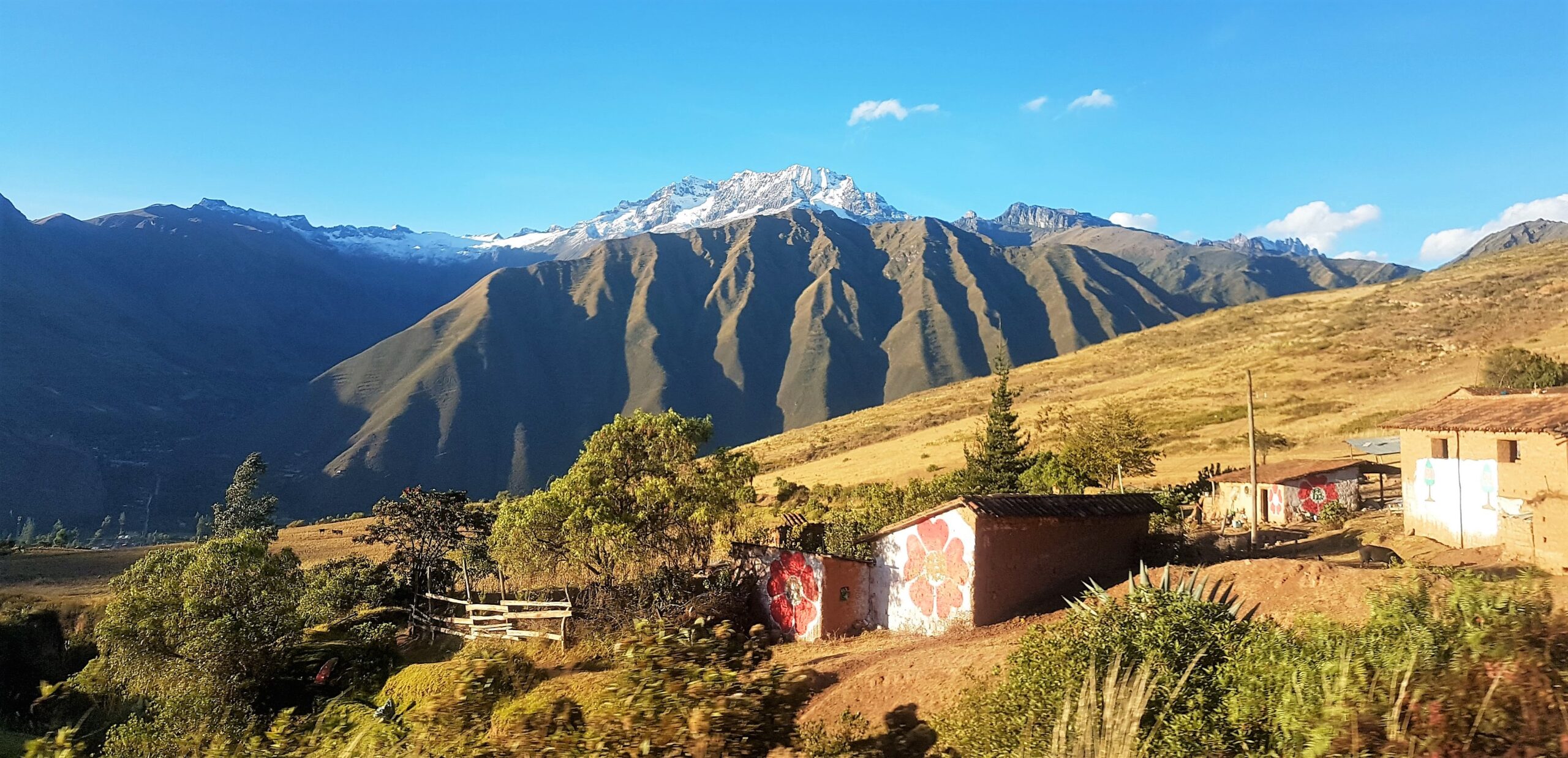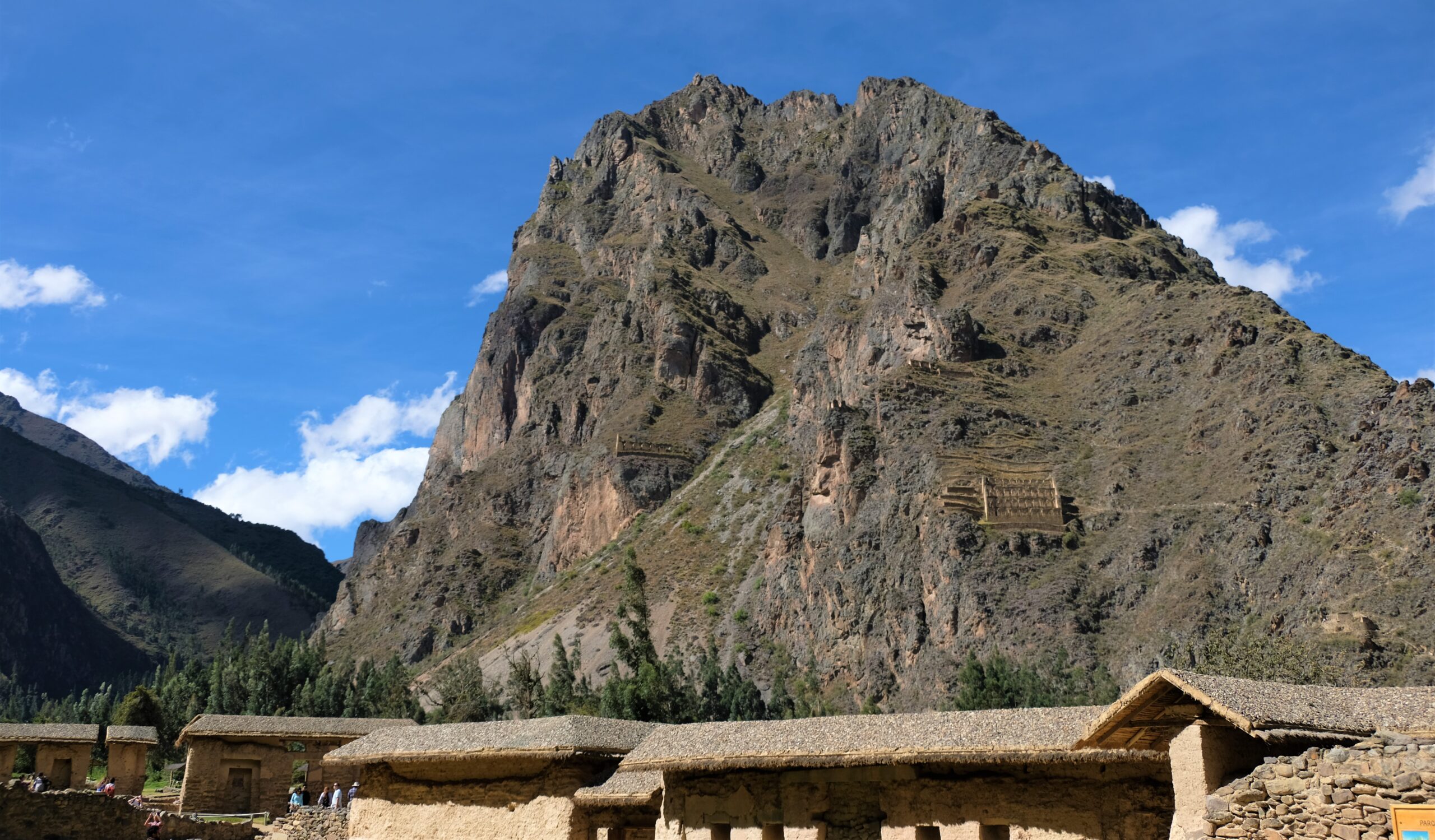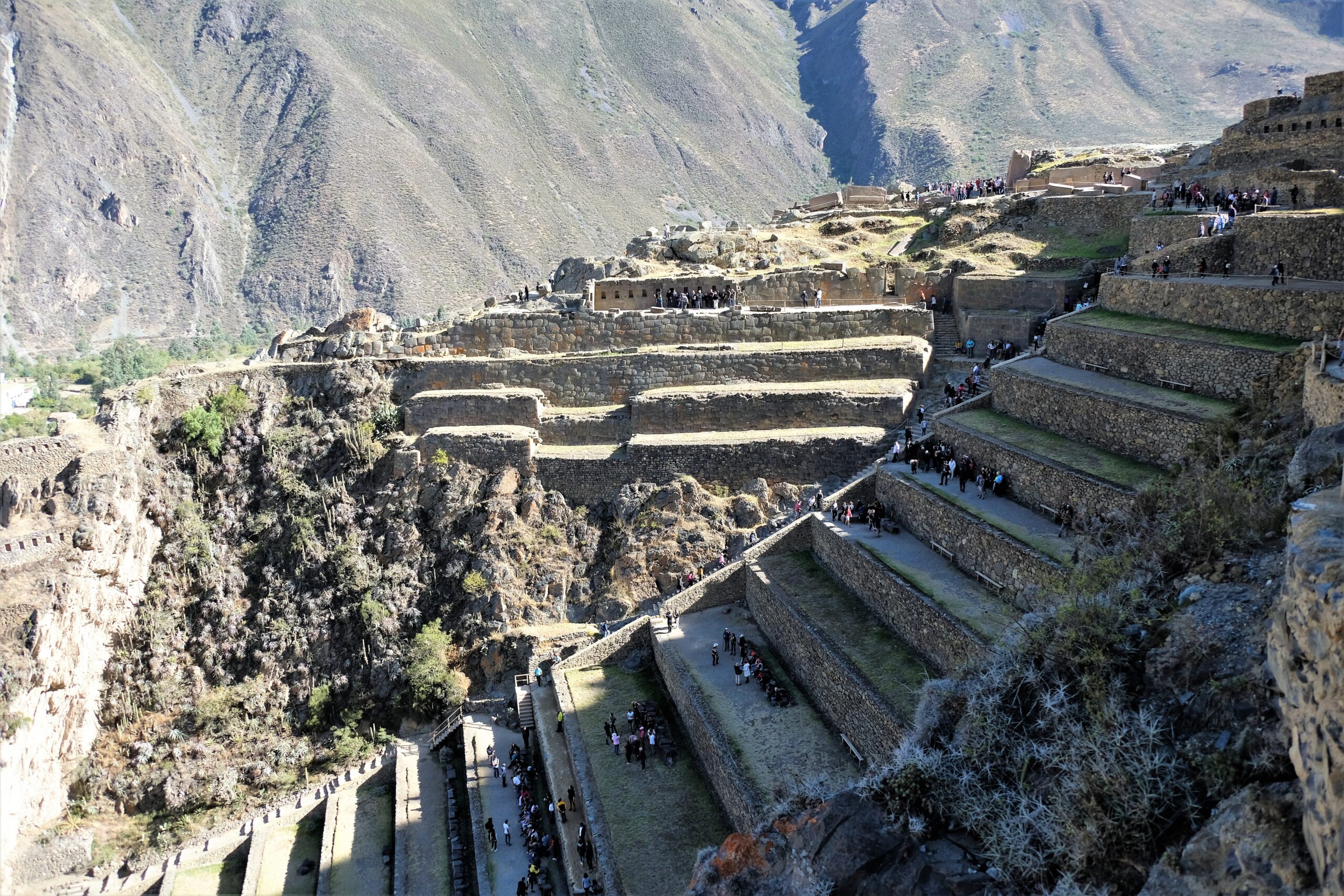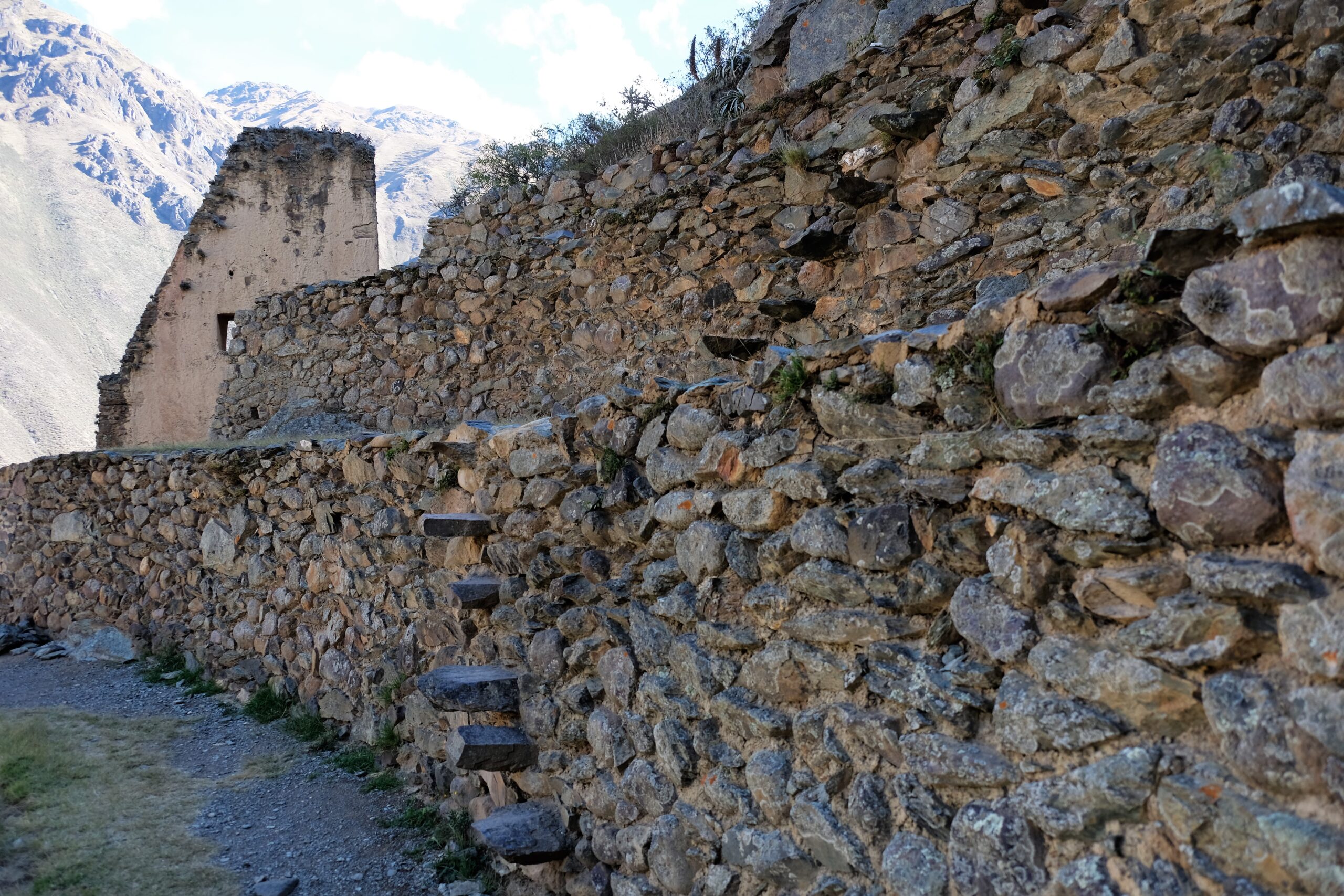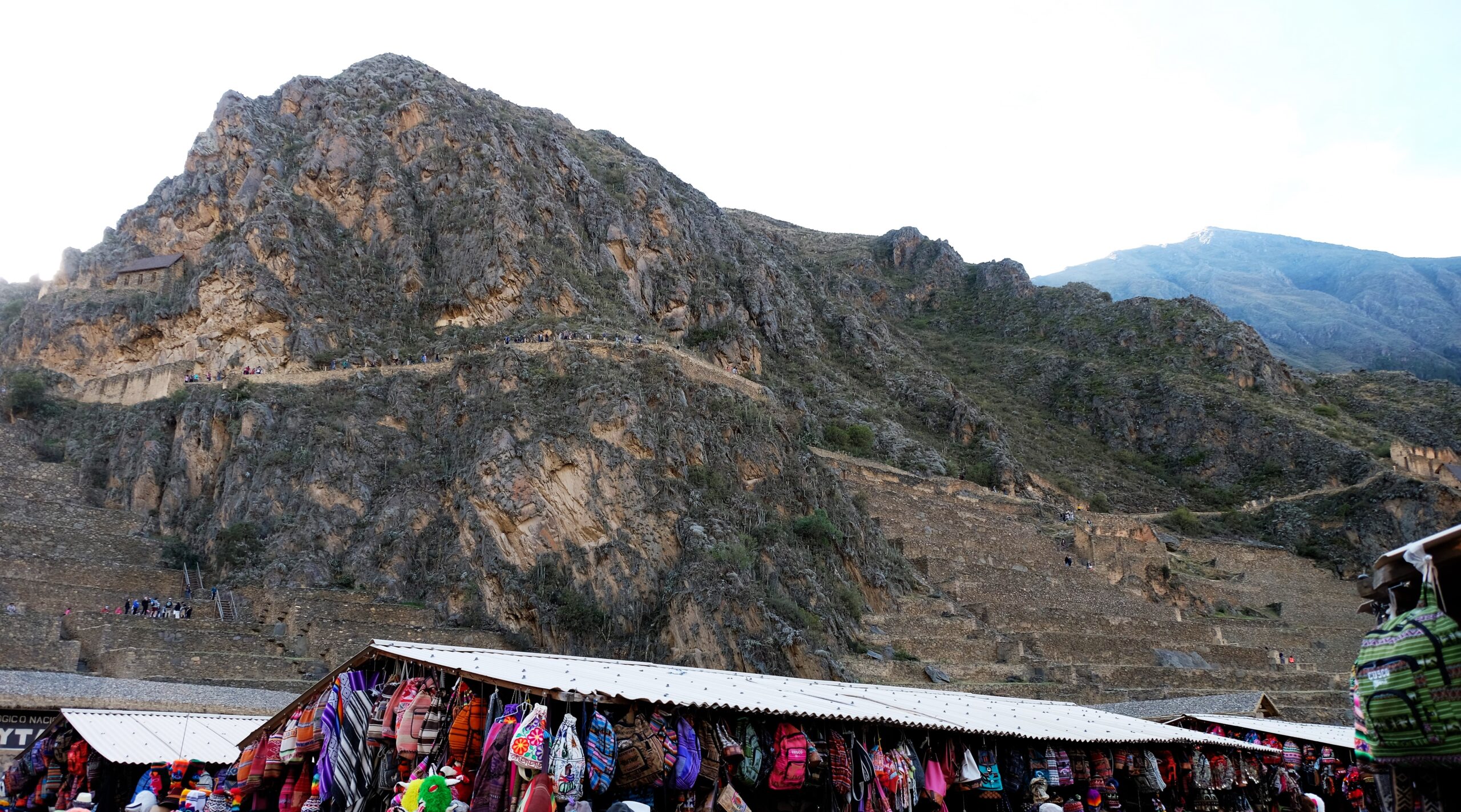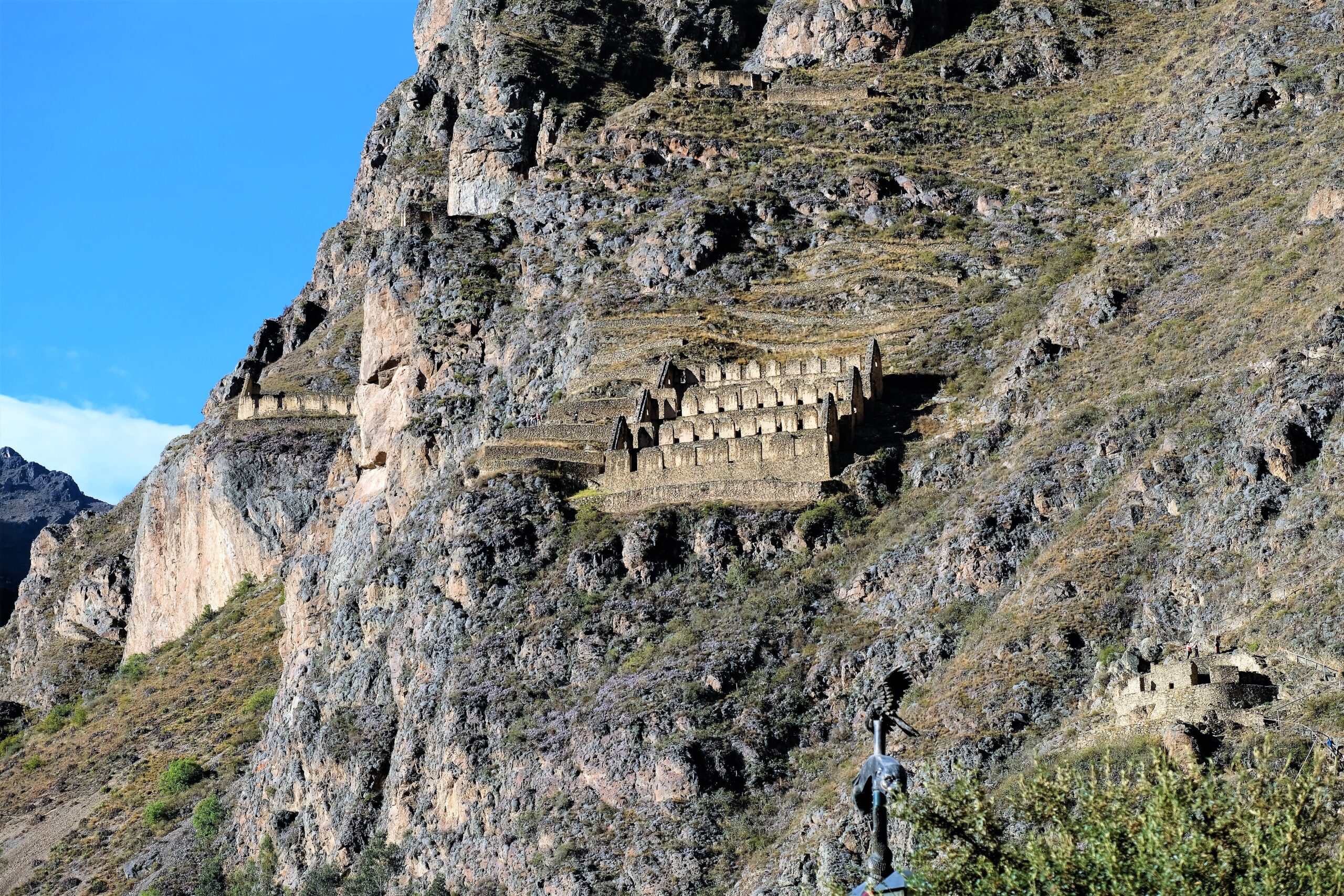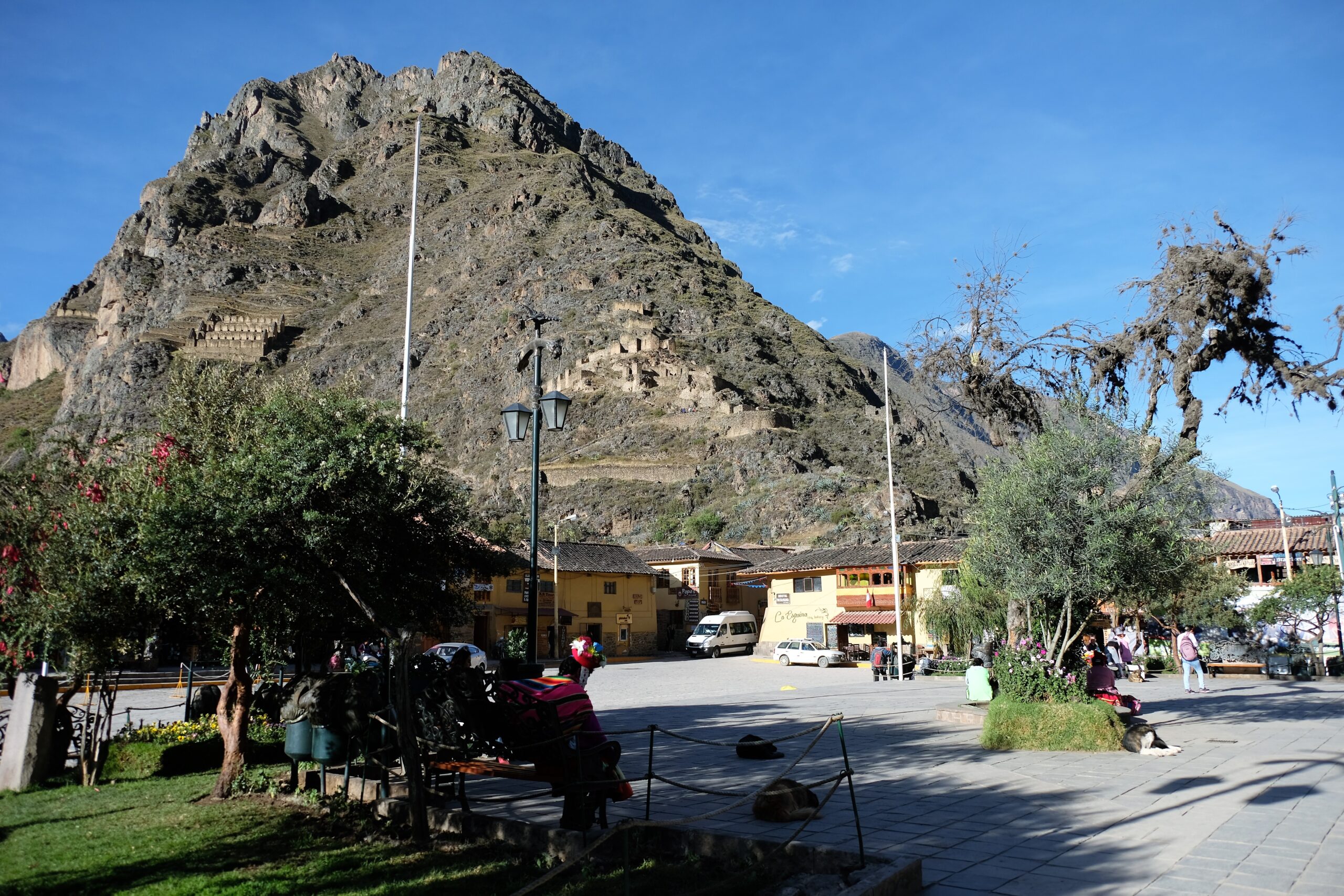Ollantaytambo is synonymous with Pachacuti and the Inca Trail. It’s one of the more famous sites and the start of most Inca Trail hikes to Machu Picchu. Along with the stunning Inca ruins the site was famous, infamous, prestigious and played a significant role in the history of the Inca Empire…long before it was “discovered” by Westerners.
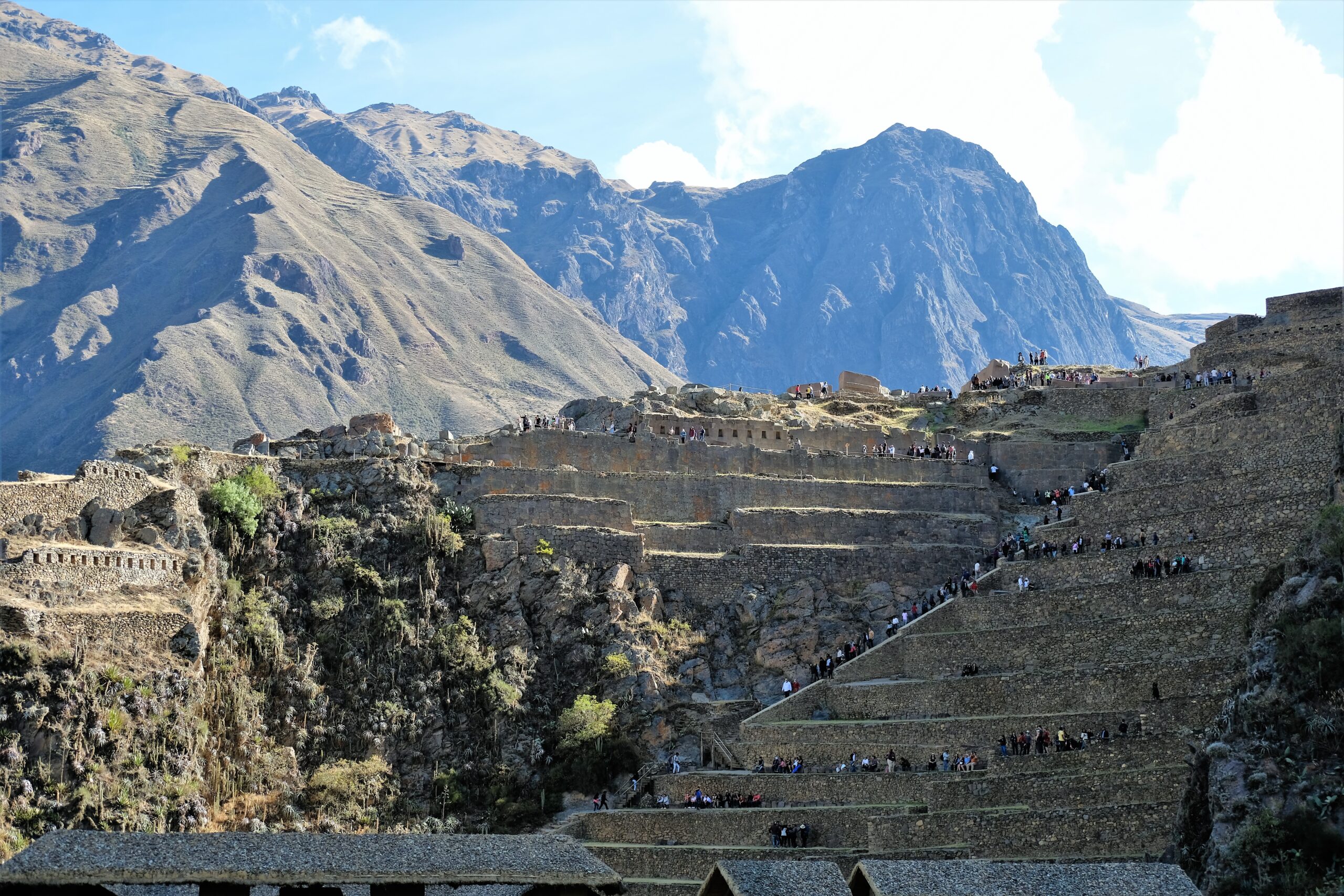
Getting to Ollantaytambo
I took a collective to Ollantaytambo from the same location as I got the bus to Moray and Maras Salt Ponds (collective pick-up), about 200m from by B&B; near the corner of Av Grau and Pavitos. Every time I got a collectivo I felt a mixture of apprehension and excitement. Did the locals understand where I wanted to go, and if not, where would I end up!? Cusco to Urubamba is around 52km and Ollantaytambo an additional 20km; why I’ve split this journey will become apparent. In all honesty, the collectivos are used to tourists, meaning my apprehension was unfounded and never ended up in some far-flung town in the middle of nowhere.
It took a around 20-25 minutes for my collectivo to fill up and then we were off. Day trips from Cusco pass through varied stunning landscapes. From flowing meadows, to snow-capped mountain peaks. If I had the choice I would have preferred to drive half as fast and stopped numerous times along the way. The scenery is vast, high and wide. From stark dark stone mountains to fast running clear rivers, dry desolate rocky fields to farmlands of browns and oranges at the start of winter. Yet even at the infancy of Winter there are oases of green and a scattering of wildflowers. Reminiscing as I write this, I can’t help but smile.
…I’ll get to the point!
Not to bore you with all the details, my collectivo didn’t go all the way to Ollantaytambo, instead dropping me off at Urubamba. Yes, I was a little concerned, but after asking a few locals and other collectivos I was told Urubamba Bus Station was only down the road – it was less than 1km way on the same road. I had lost around 20 in the morning, another 20 asking around to get to Urubamba Bus Station, then another 30 minutes at least waiting for my collectivo to fill up and head off!
Oh boy do some collectivos fill up! I had a few instances where it felt like everyone had bought their monthly shopping and all decided to get into the same collective. All in all, on every journey the people (driver, customers and passengers) were all friendly, but kept to themselves. My delays exclude the occasional stopping along the route to drop people off &/or pick up more people. Just a quick addendum; at no time did the minibuses get so full that I thought it was unsafe.
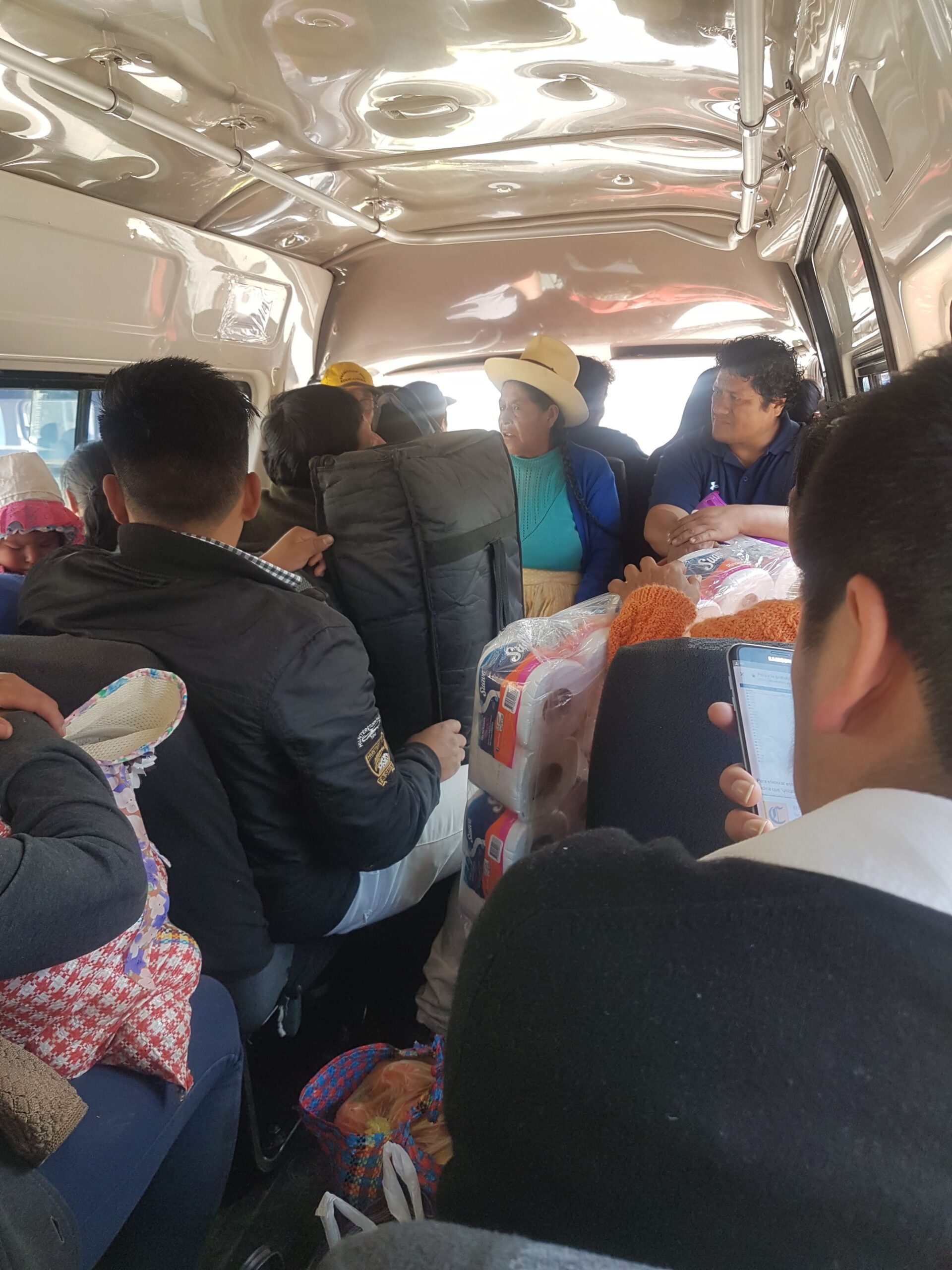

Travel Tip
Ollantaytambo isn’t the biggest site, though it is large. The surface area is about the same size as Sacsayhuamán/Saqsaywaman, but the terrain makes it more time consuming. You can easily see the main parts in an hour or two, but that’s not my cup of tea. I tried my best to see as much as possible and climb as many paths as I could find. However, I didn’t get to hike the path on the opposite hill with the large pinkuylluna (archaeological site on the opposite mountain), nor get a close-up of Viracocha/Tunupa. Nor did I get to stroll through the town either, grrrrr!
All this because of the delays in my journey. Cumulatively I must have lost around 2 hours, that includes me diddle daddlying. So, if you want to fully explore Ollantaytambo I’d suggest get there early. That would also help with the lighting, I really struggled with the variable shade, very dark in some areas, bright sun and reflection….that’s just a heads up that the pictures aren’t the best.
History of Ollantaytambo
The place derives its name from the Quechua work “Ulla-nta-wi”, meaning “place to look down” – “tambo” was a later addition. However, in traditional Quechua the name stems from a love story, the Quechua version of Romeo & Juliet. An fierce Inca army captain “Ollanta”, fell in love with Pachacuti’s daughter Princess Cusi Coyllur. This class/stature difference was forbidden, especially since it was the Emperors daughter, forcing Ollanta into exile. He rebelled against the Inca Empire for almost a decade until he was captured. After which he explained his actions to Pachacuti who forgave him and allowed the two to get married.
Now for the real history. There are three primary phases to Ollantaytambo; firstly, pre the conquest of the region by Pachacuti – of this period very little to nothing is left. Secondly, after the conquest the region became part of Pachacuti’s personal estate. Almost all of what is seen today is a result of his construction work i.e. palace, temples, terraces etc. Thirdly, during the time Manco Inca used Ollantaytambo as a fortress to fight off the Spanish Conquistadors. Yes, the same Manco Inca I mentioned in my post about Chinchero. He changed this palatial site into a fortress, but exactly what he did isn’t certain. The pictures may help with this, some areas look complete, others changed and others incomplete.
Pachacuti’s reign was circa. 1438-1471/2 and he conquered the region in the middle of the 15th century. After his death the estate went to his extended family/clan. He built loads; many temples, a ceremonial centre which is mainly at the base of the hill. Terraced the hillside for farmland including creating a complex network of canals and aqueducts.
What to see:
Terraces of Pumatallis
The terraces can’t be missed, literally ?. Like steps made for a giant, they cascade down the hillside. The whole of Ollantaytambo is very well laid out; the terraces and buildings all seem like they were constructed simultaneously, fitting seamlessly into each other and into the mountain slope. I don’t know if this is accurate, but the name Terraces of Pumatallis is only in reference to the main terraces leading up to the Temple of the Sun. The other terrace around the corner doesn’t have a name. I may be wrong about this. All the terraces are in great condition. They, along with the whole area, would have looked so different during Ollantaytambo’s prime, bustling with people working the terraces.
These terraces are much taller than those I had seen before; quite easily 2m high and maybe 4m wide. I’d go so far as to say the quality of their construction is much better too. They are built masterfully, with cut stone to give them perfect lines with very few jutting out. This was the estate and hence a showpiece for the most powerful person in the Inca Empire, the quality of the work through Ollantaytambo represents his prestige. Not just in the temple buildings, but even the terraces have a touch of class I had not seen at other Inca sites.
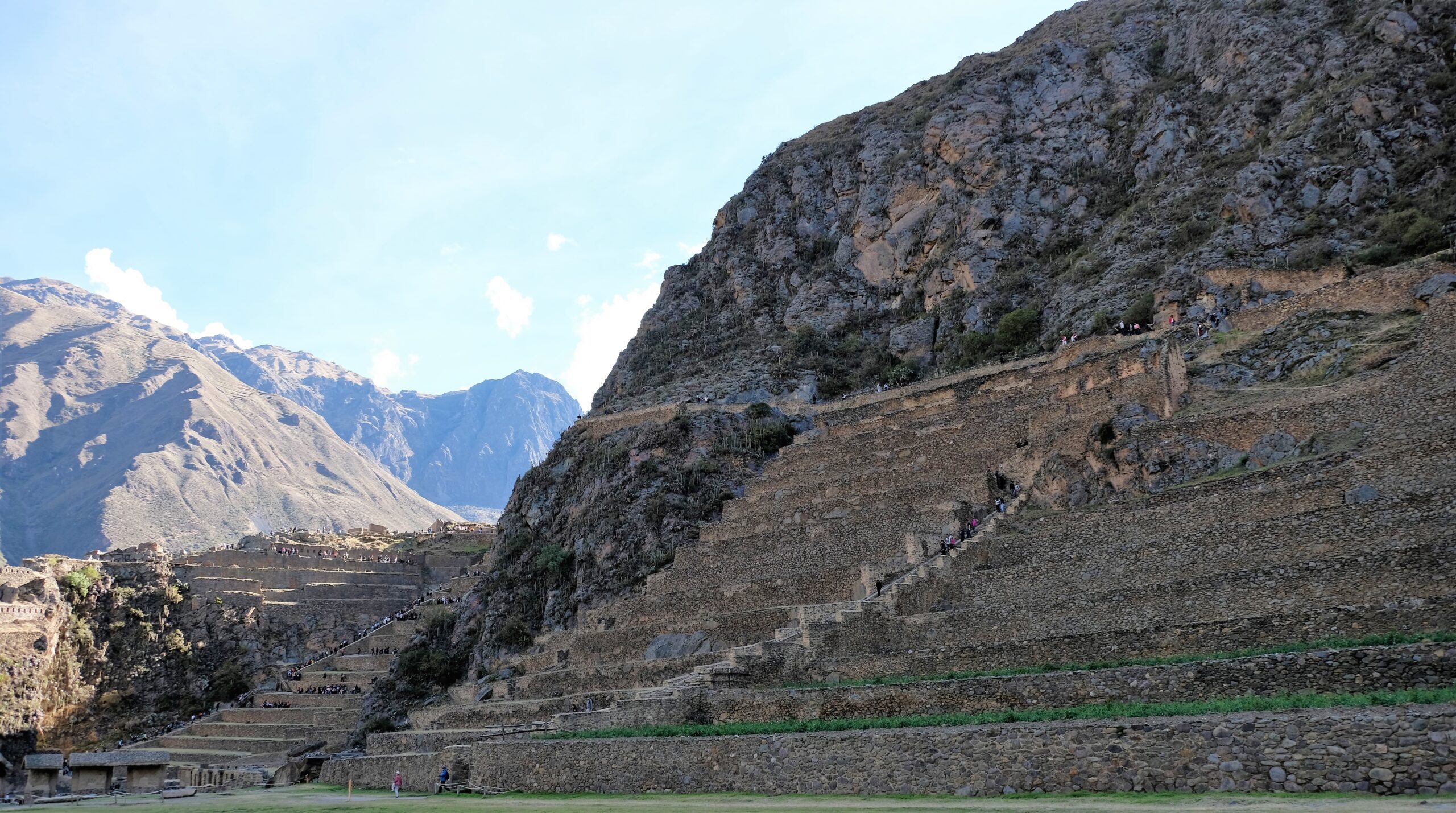
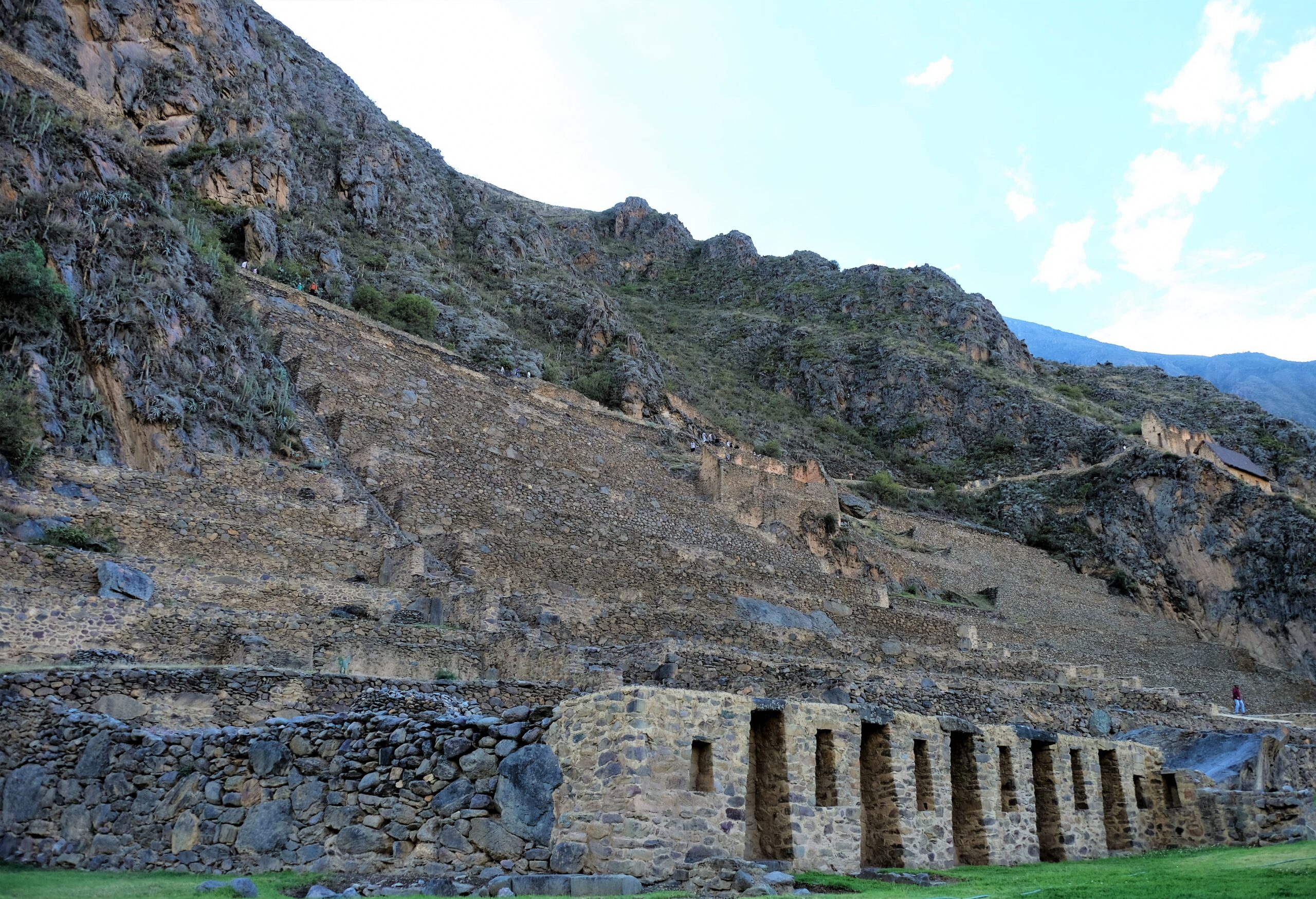
Temple Hill
The Terraces of Pumatallis do add a sense of grandeur to the buildings at the top…not that they need it. Walking up (stairs) you can’t help thinking you are going somewhere important…indeed you are. As you get to the top of the stairs things start getting a little confusing. To the right the terraces continue but include some buildings and walls with niches. On the left, the stonework is distinctively of greater size and quality. Here the mountain juts out to form a natural large outcrop, like a shelf.
It’s confusing because on the left, is an array of buildings for ceremonial and religious purposes. Their stones crafted to create smoother surfaces and they are much larger than those used for the terraces and other buildings (most) throughout Ollantaytambo. I was a little disheartened because it looks like some buildings had been dismantled, maybe in the construction to fortify the hill. Many of the buildings were never completed either, with many massive square and rectangular stones lying around.
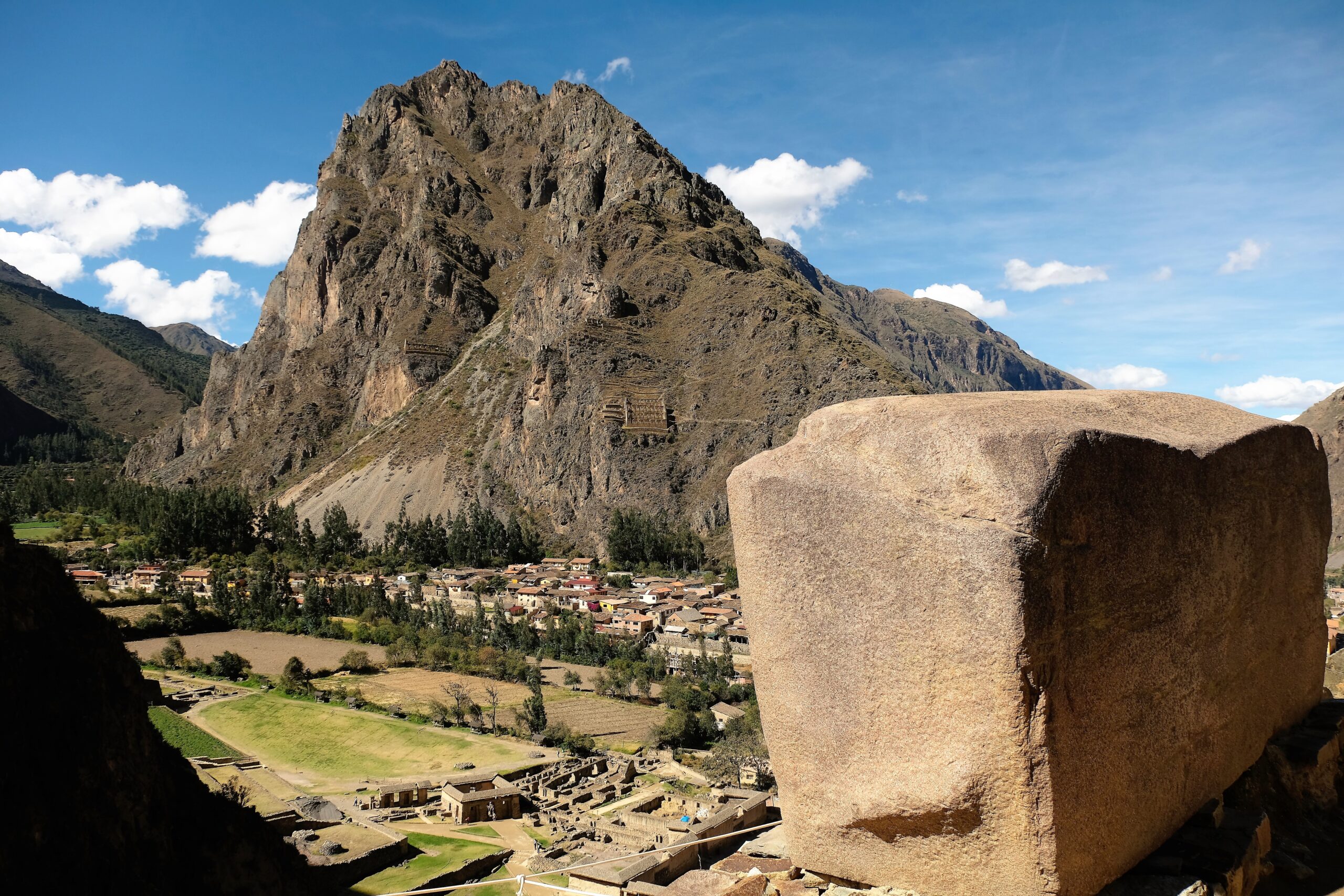
Enclosure of the 10 niches
Before you get to the main temple area you pass along a balcony or sorts which leads past the Enclosure of the 10 Niches. Sure these are interesting and can be seen from the bottom of the mountain giving them the look of a wall with neat aligned windows. If they had fires burning inside the niches they would be seen from kilometres ways along the Sacred Valley. But what impressed me even more was the stone wall leading to the 10 niches.
Large smooth stones of various squared shapes; flat smooth surfaces rounded at the edges, fitting together like a jig-saw puzzle using no mortar. The larger of the stones, of which there are many, must weigh nearly 2+ tons! Considering most of the stone used here is granite is a testament to the Incas stonemasonry and construction skills. Along with these skills you cannot underestimate their logistic and ingenuity either. The quarry is a few kilometres away, add in the elevation to get these large stone up the hill takes real expertise. Sadly, the Incas construction methods are long gone, just like so many other ancient civilisations.
Their use?
The actual function of these niches isn’t definite. Commonly thought to be or represent Pachacuti’s ancestors or some sort of homage to them. There is credence to this thought as all sacred Inca places have niches. These could have held a representation of a deity or ancestor, maybe even a body part similar to churches having bones of Saints on display. There is actually another wall with more niches further down the hill, two walls in fact. These are on the same outcrop but lower down. These were part of the defenses and I was told they actually predate the Inca Empire i.e pre-Pachacuti. These walls wrap around the face of the hillside and look similar in quality to the terraces.
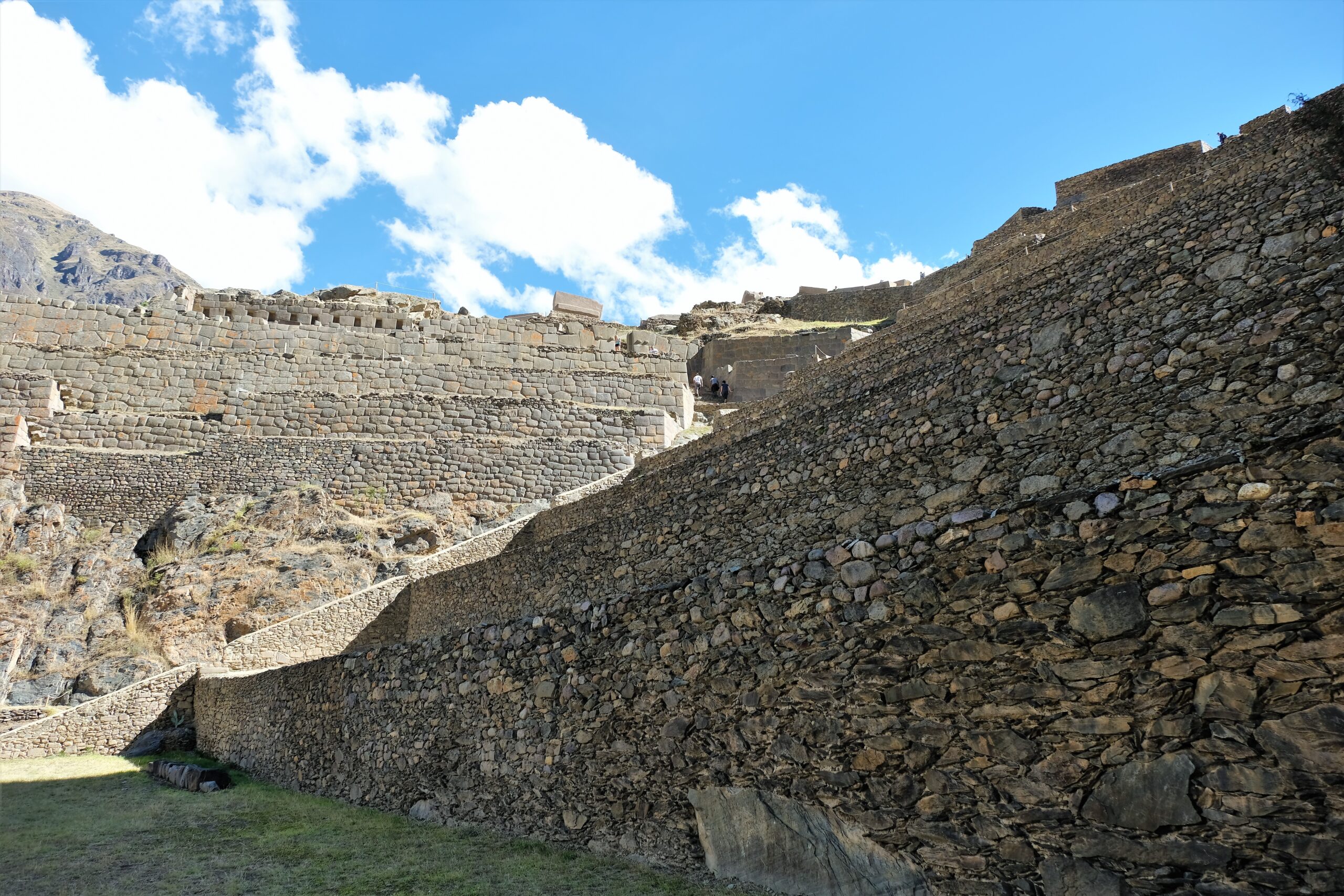

Wall of the 6 monoliths
From the Enclosure of the 10 Niches i.e. behind, is where the main temple/s were located. Not much is left of the buildings; some were never completed, and it looks like there were structures which were dismantled too. This could be for a few reasons. Firstly, they were simply never completed. Secondly, when Manco Inca fortified Ollantaytambo he used the stones. Thirdly, when the Spanish took over the region (Hernando Pizarro, one of Francisco Pizarro’s brother, was given the region to govern), they dismantled anything pertaining to the Inca religion, leaving only the larges stones untouched.
In this area there would have been a few structures, all of which would have been part of the Temple of the Sun. The wall of the 6 monoliths would have been the epicentre, the main Temple of the Sun (Sun Temple). These 6 monoliths are huge, weighing around 50 tons each! Considering the Incas hadn’t encountered or invented the “wheel” and only using copper and bronze these monoliths are amazing. One thing that stood out to me was at the bottom of one of the monoliths: a protruding notch in the shape of a polygon. I’ve seen this and similar at a few sites, including the wall leading to the Enclosure of the 10 Niches. On that wall there were a few stones with two protruding notches. My guess is these were used/needed as part of the transportation &/or to lift/move then into position…who knows.
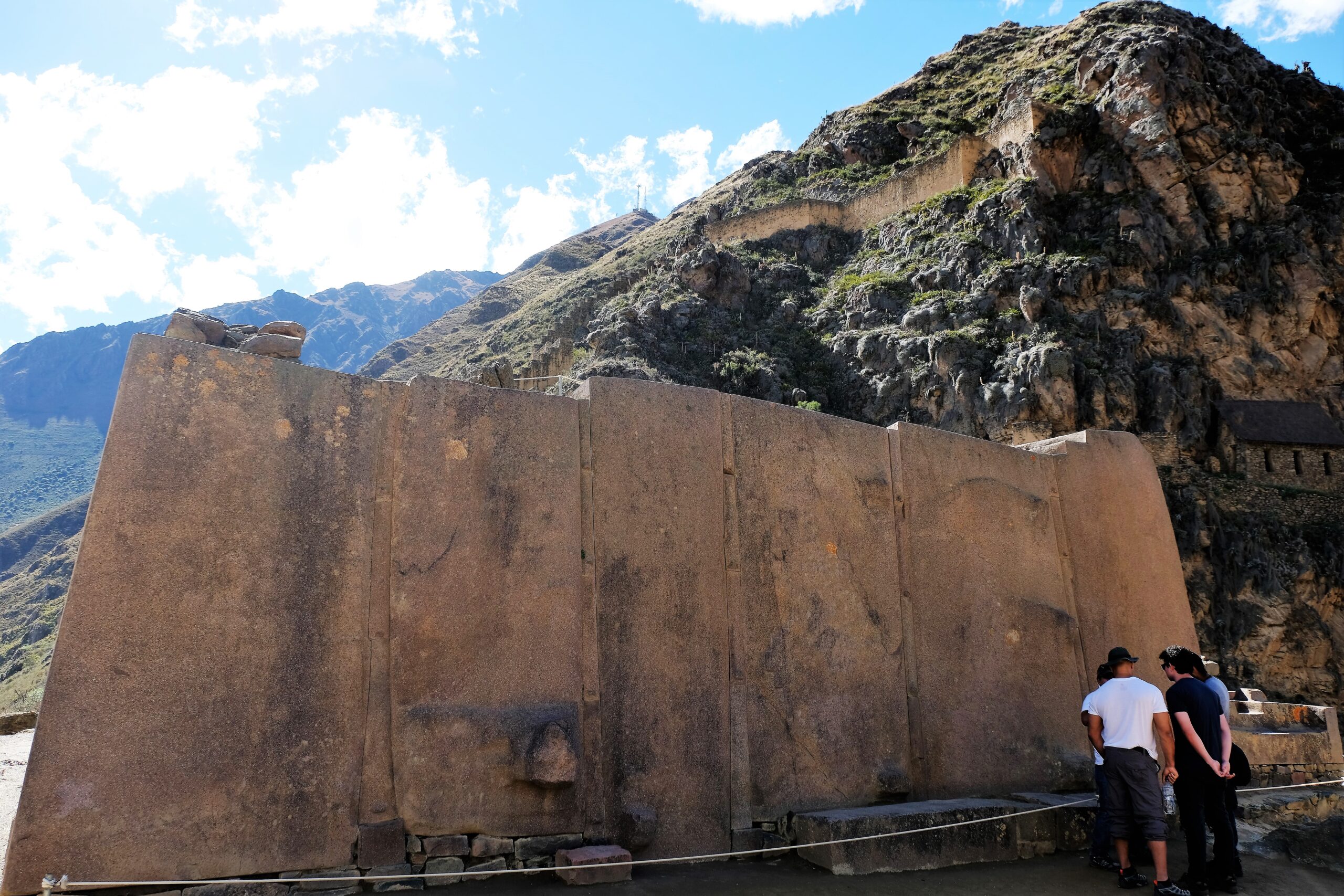
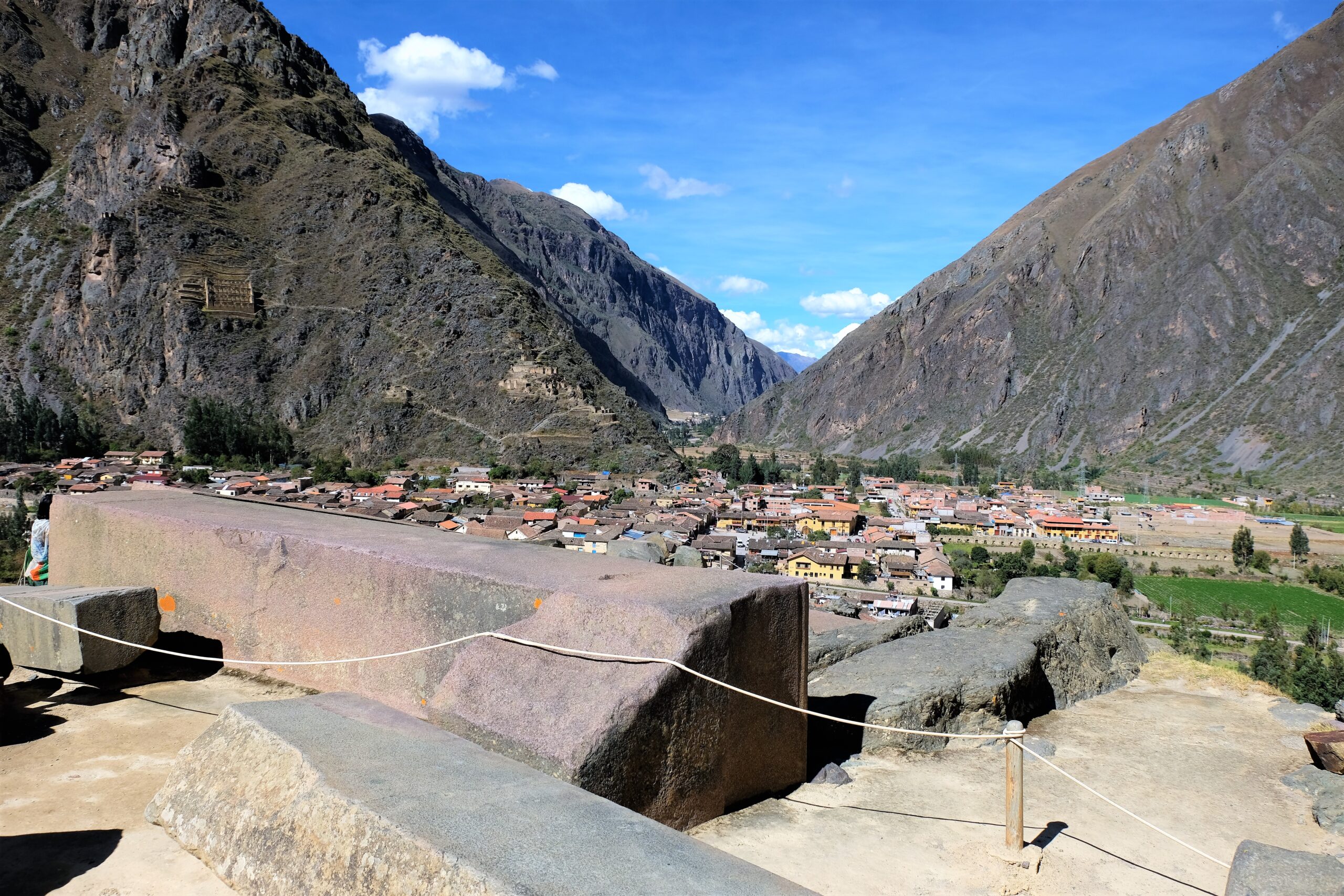
Inka Watana / Intiwatana
The views from the temple complex of the valley below is fantastic, but not as good it you head further up the mountain. I didn’t know there was anything further up the hill except for the high walls that wound the mountain. With so many building structures behind the Wall of the 6 monoliths it’s difficult to get your bearings walking through what feels like a labyrinth. This area was supposedly for the military; whether this was built prior to Manco Inca I have no idea. They are well built but not refined and look similar to the defensive wall that snakes up the mountain.
I had no idea where I was going. I found a path that looked to lead up the hill. To be honest there was nobody there, so I was keen to that a route to get away from the crowds. The path is steep and slipper at time and took about 30 minutes to get to the top. Here I found Inka Watana. Other than being a sacred/religious place I have no idea what is was actually used for (if you know please let me know!). An interesting feature was the circular holes cut through the stones on the vertical columns all at the same height. I thought these could have been part of rope hinges…?
It is a bit of a hike up to Inka Watana, and in all honesty, there are many more interesting things to see below. But, the hike up is well worth it for the views of the valley below. Up here you have a near 270-degree view. Below, the Sacred Valley stretches out as far as the eye can see. Like a green snake winding its way between the mountains as it follows its prey…the Urubamba River.
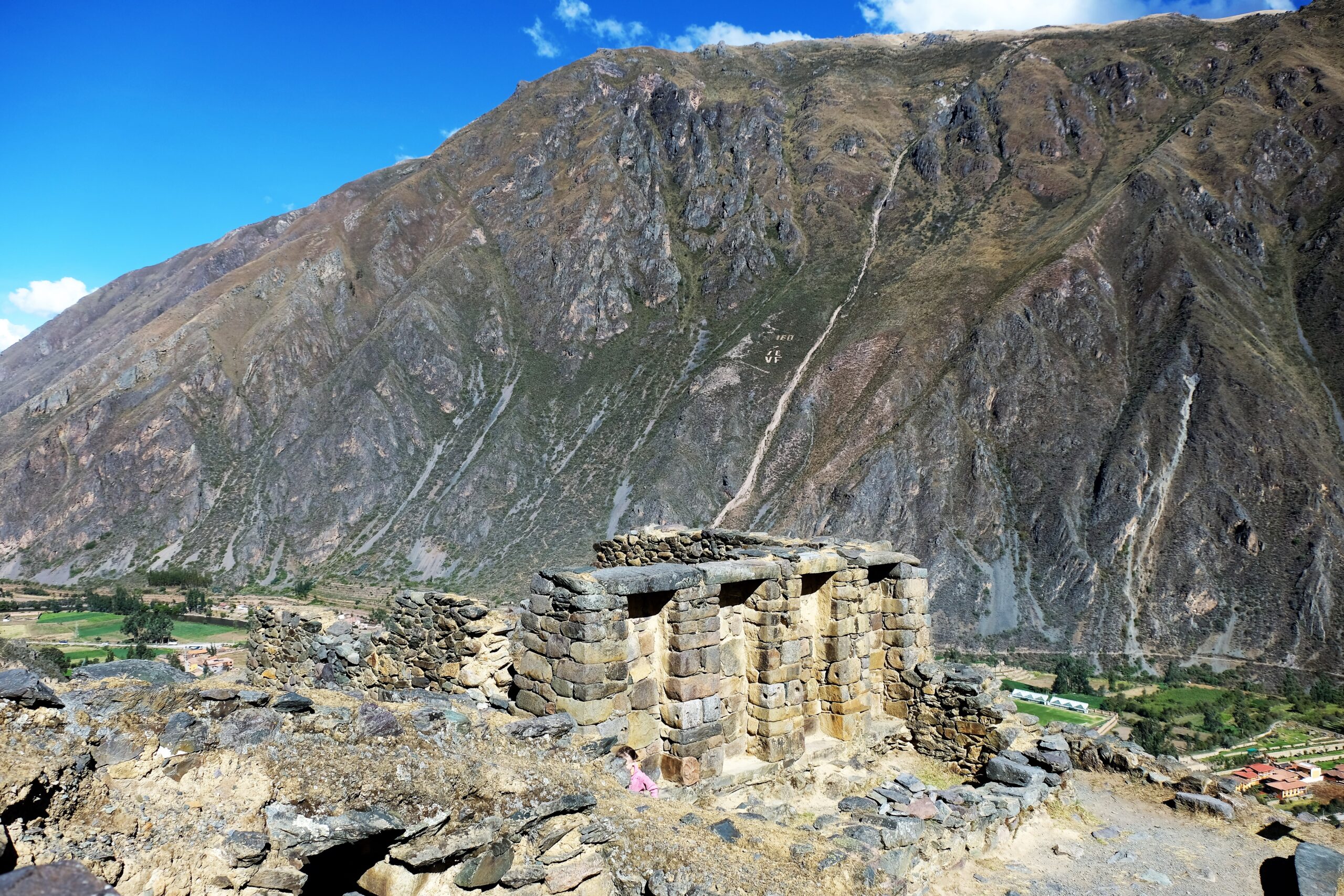

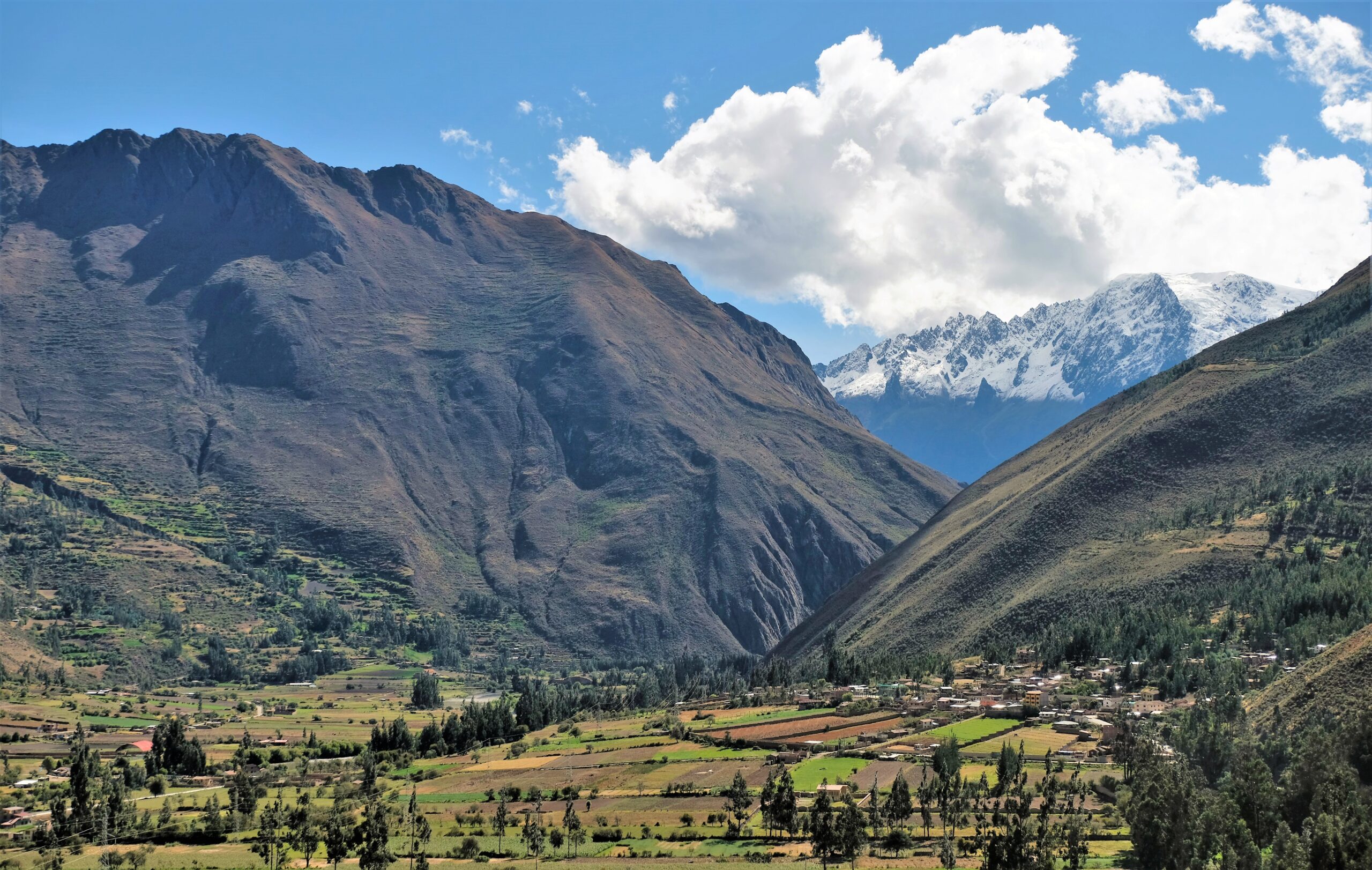
Pinkuylluna / Pinkulluna
From here you get a great view of Pinkuylluna; the archaeological site on the hill opposite. Here the qullqa/qollqa look like mini cathedrals but are in fact store houses; used to store their produced. It seems counterintuitive to drag produce up a hill for storage, but there is method in this madness. Firstly, the higher altitude means there is more wind which is good for ventilation, Secondly, the lower temperatures helped prevent decay.
Qullqa are also designed to aid in ventilation. They have larger windows at the back (closer to the mountain face) and smaller in the front. This system meant they filled the qullqas from the back and emptied them from the front. I was, and still am disappointed I didn’t get to hike up to the qullqas. Pinkuylluna archaeological site has quite a few structures, not just the qullqas. Of these other structures is the Face of Viracocha.
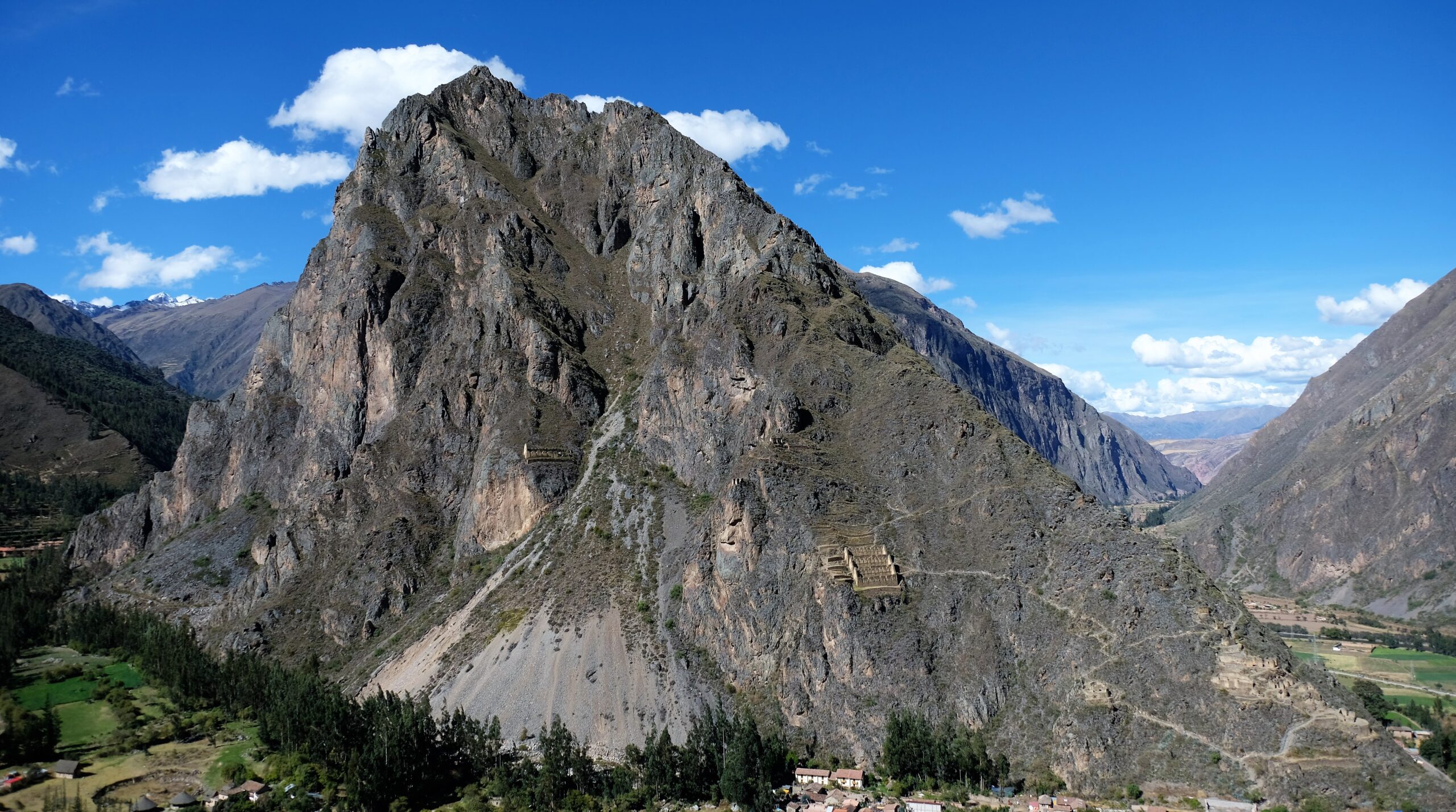
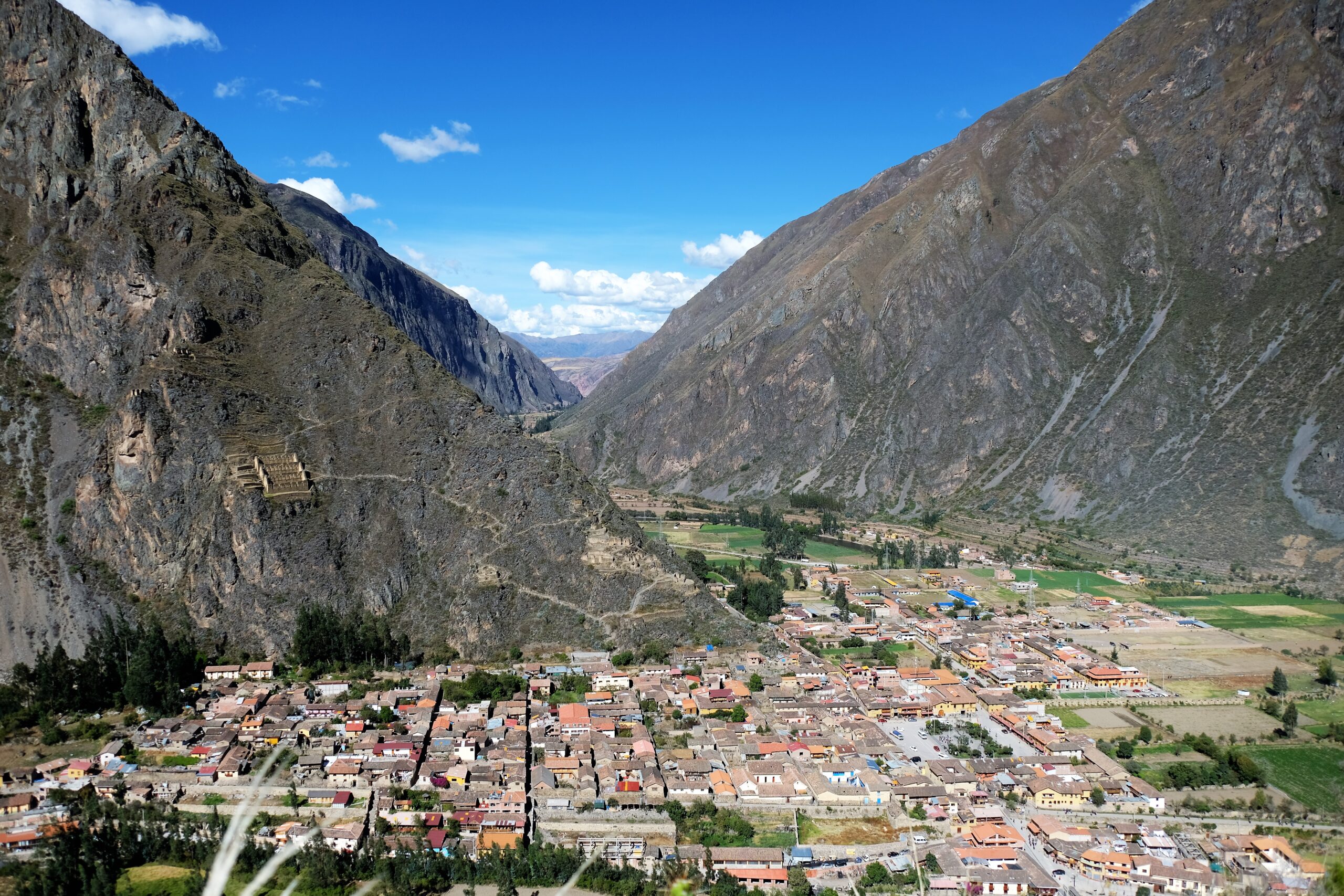
Virococha
Now a little worn down by time an erosion, you can’t miss the unmistakable carved mountain face. For the best views that encompass the whole Pinkuylluna site I’d say are from Inka Watana. Though without doubt I would have preferred to see the Face of Virococha from up close. Virococha is the Inca god of gods, the creator god. A fitting location for Virococha to oversee Ollantaytambo.
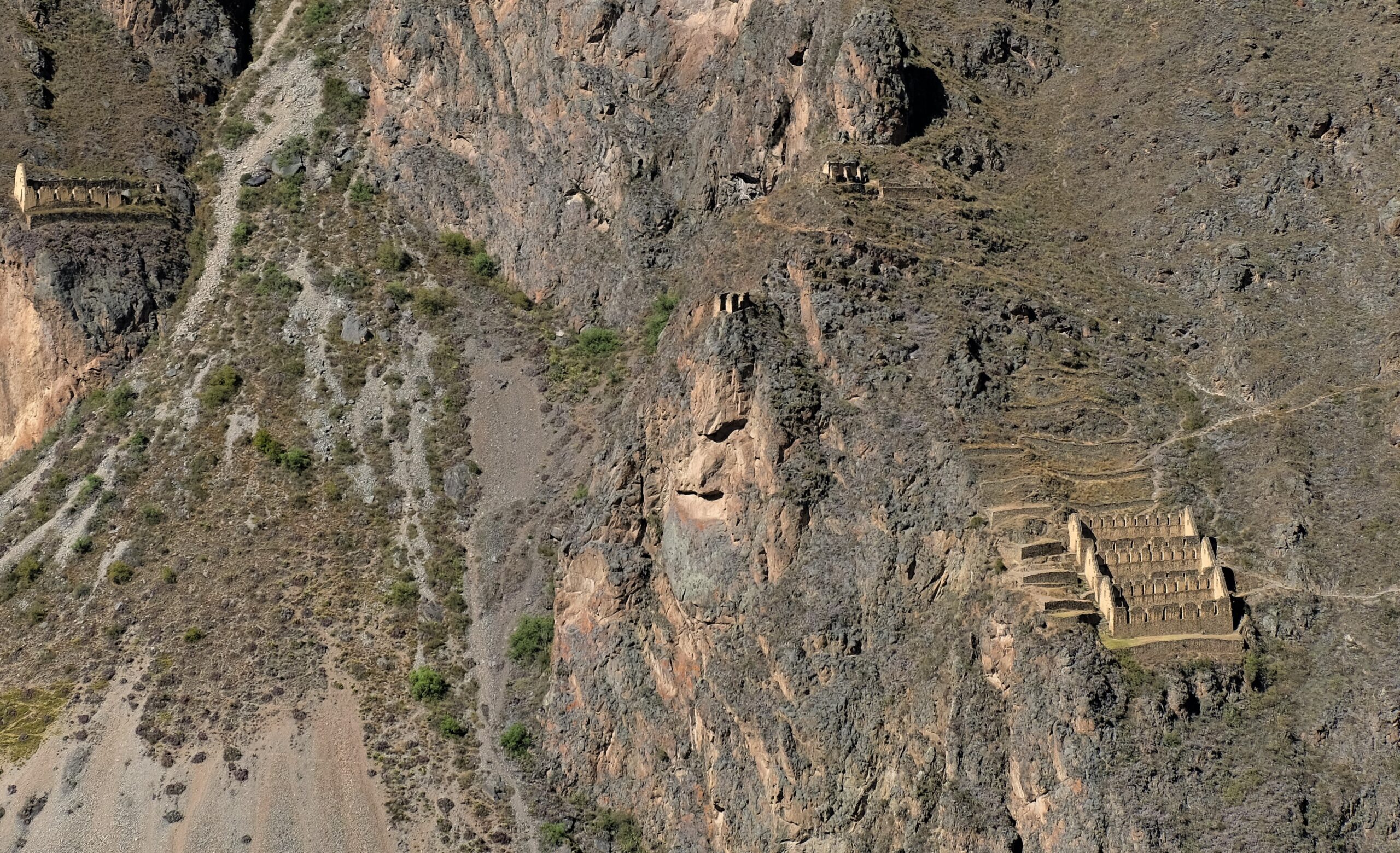
Balcon pata / The balcony
The balcony joins the Terraces of Pumatallis with the adjacent terraces around the corner. The path blends into the surroundings running at the top of the terraces as it caresses the mountian. Along the route are buildings that seems to be part of the mountain itself. At such steep angles and terrible access (none that I could see) they must have been a challenge to construct, I wish I knew their purpose. Along the route are more qullqa, though not in the same condition as those on Pinkuylluna. If you look throughout Ollantaytambo beyond the main tourist sites you will see Inca buildings and structures everywhere. Not all are accessible, I don’t think everywhere is open to the public either. It does give a better perspective of the size and scope Ollantaytambo once occupied. Just down the road from Ollantaytambo is an Inca bridge, their quarry, more terraces etc. etc.
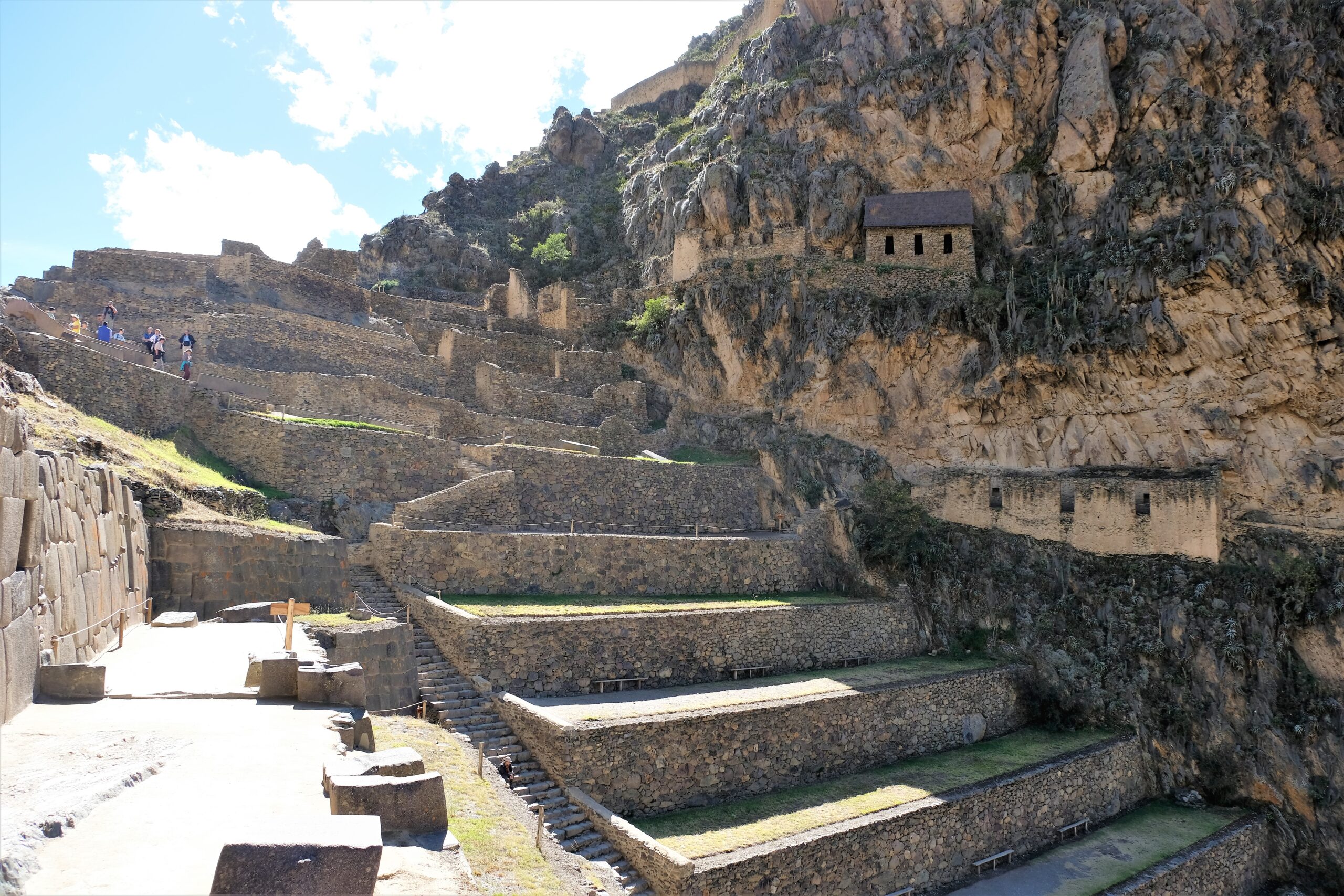
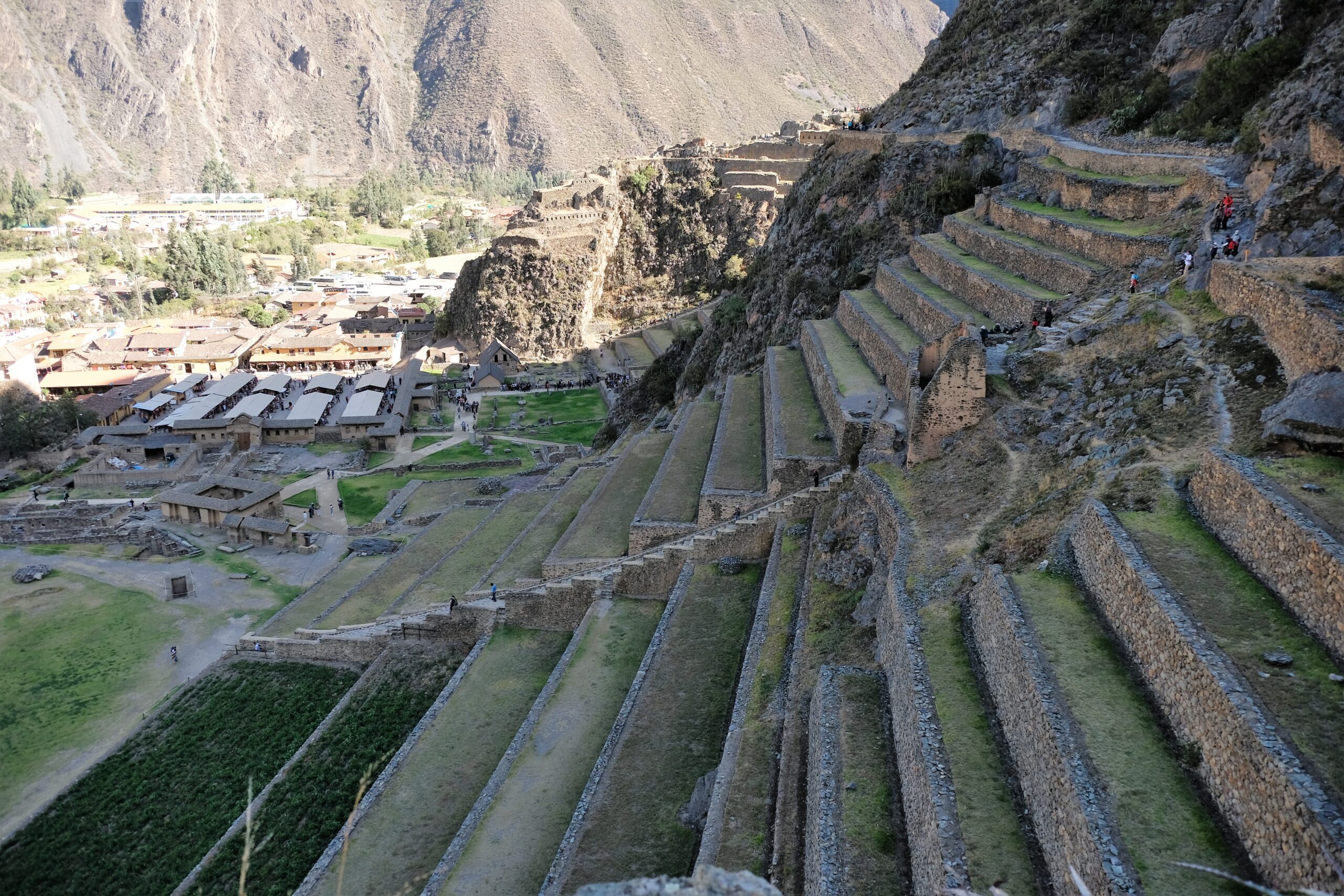
Manyaraqui Plaza
At the base of the Terraces of Pumatallis is a large ceremonial complex mostly associated with water centred around Manyaraqui Plaza. Now a large grassed area scattered with random rocks, the remaining buildings of what would have been an important area is more touristy. Remnants that can be seen is still impressive but want can’t be seen is even more so i.e. the plumbing that feeds the many fountains and baths.
The Patakancha/Patacancha river feeds this ceremonial area. The Incas split the river with aqueducts, I saw three that were still in use. Now they look part of the landscape but upon close inspection you can see they are manmade. What you can’t see is how they feed the rest of the ceremonial area…and have done so for over 500 years. The carved stone in this region is of the highest quality. They may not be the biggest stones, but they are exquisitely cut at right angles and polished as smooth as glass. There are lots of buildings in various stages of disrepair, and many beautifully worked stone laying around. The good news is (I hope), in some areas it looks orderly as if archaeologists are sorting the stone out in order to reconstruct some of the temples.

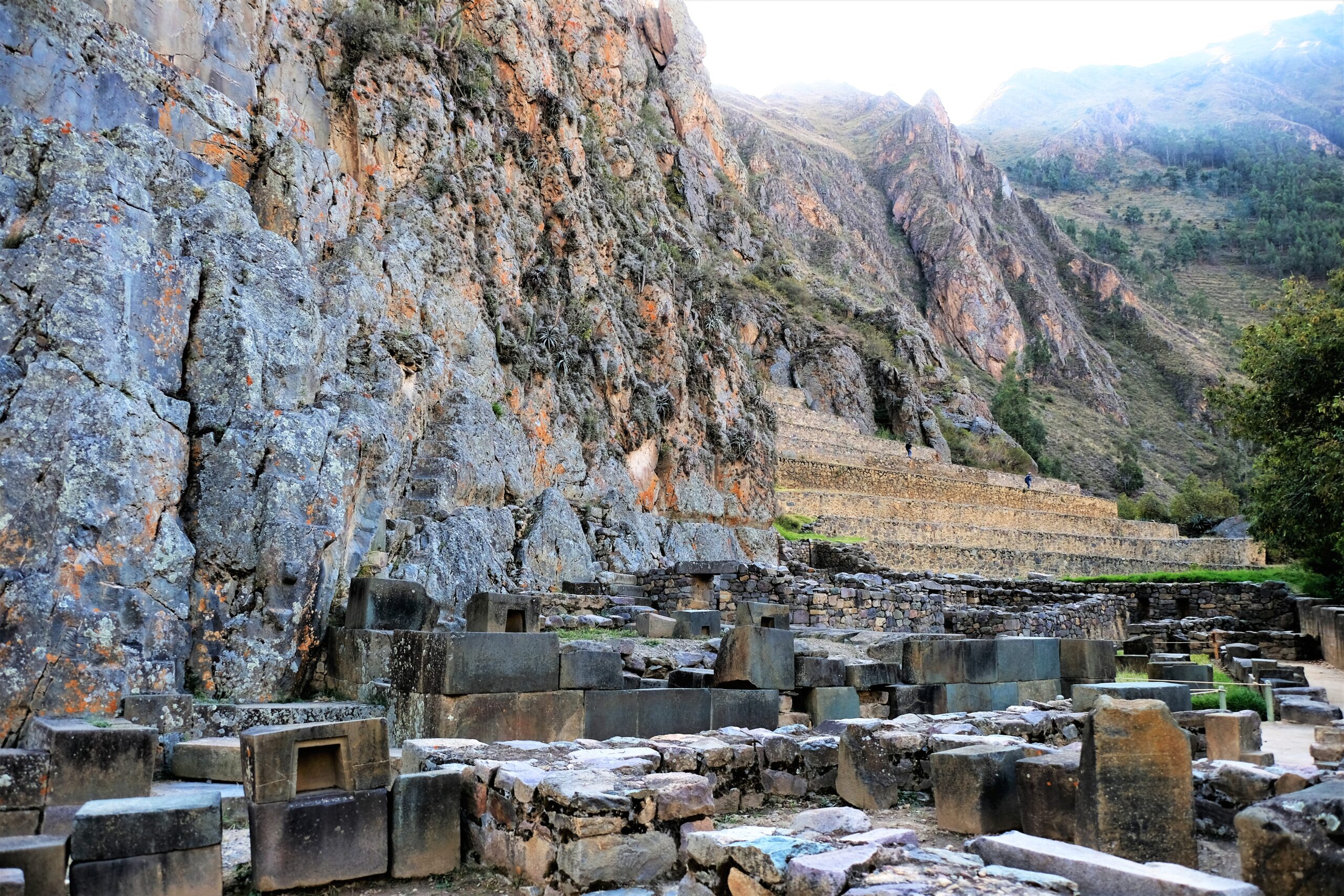
Some interesting sites at Manyaraqui Plaza
Temple of the Condor
There is a rock outcrop on one of the cliffs, the same side as the terraces. It resembles the head of a bird of prey, and below at ground level the rock as been shaped and cut similar to many other sacred sites. I couldn’t find out anything about the authenticity of the Temple of the Condor, but the rock below does lean towards an area of importance
Incamisana Water Temple:
-
- There are 14 fountains in total, the majority are still in working condition
- Princess Bath/Banos de Nusta /Ñusta Bath is the most visited but the other are no less tranquil and elegant
- Those that are no longer working (at least when I visited) in my opinion would have been even better. I can imagine the Incamisana Water Temple complex would have been very tranquil. The sound of gentle running water from all angles faintly echoing between the opposing mountains.


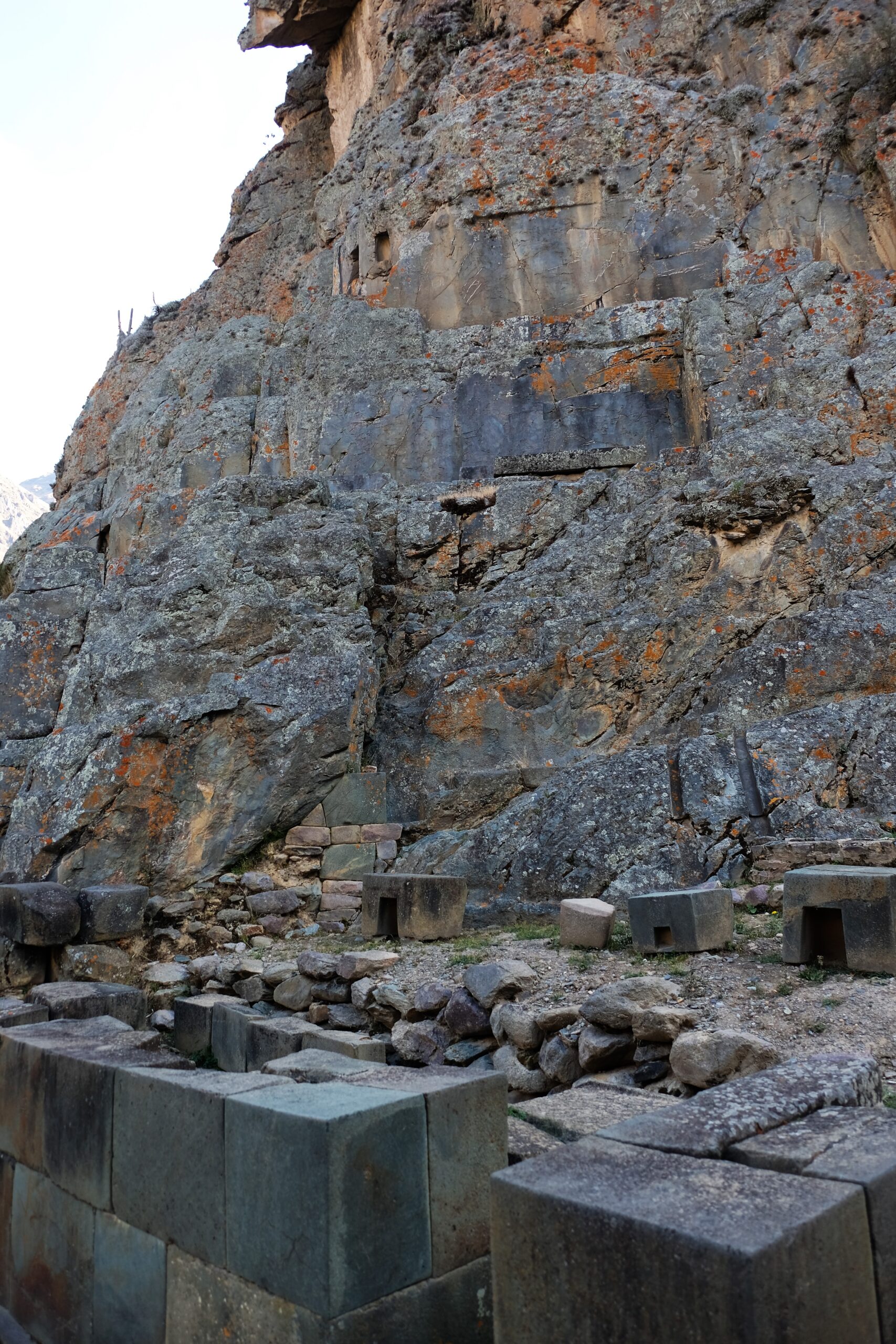
Doing it differently
This was a challenging one to write about. To start with. I should have spent more time there. In retrospect I should have stayed at least 1 night in Ollantaytambo (more like 2 nights 3 days) to fully explore the area. Then, as it goes with Inca sites, accurate information is sparse at best. That being said, I’m a little disappointed with this blog if you include the pictures – for reasons already mentioned.
Anyway, the next day I would head to Pisaq, another awesome site…with loads of stairs!
